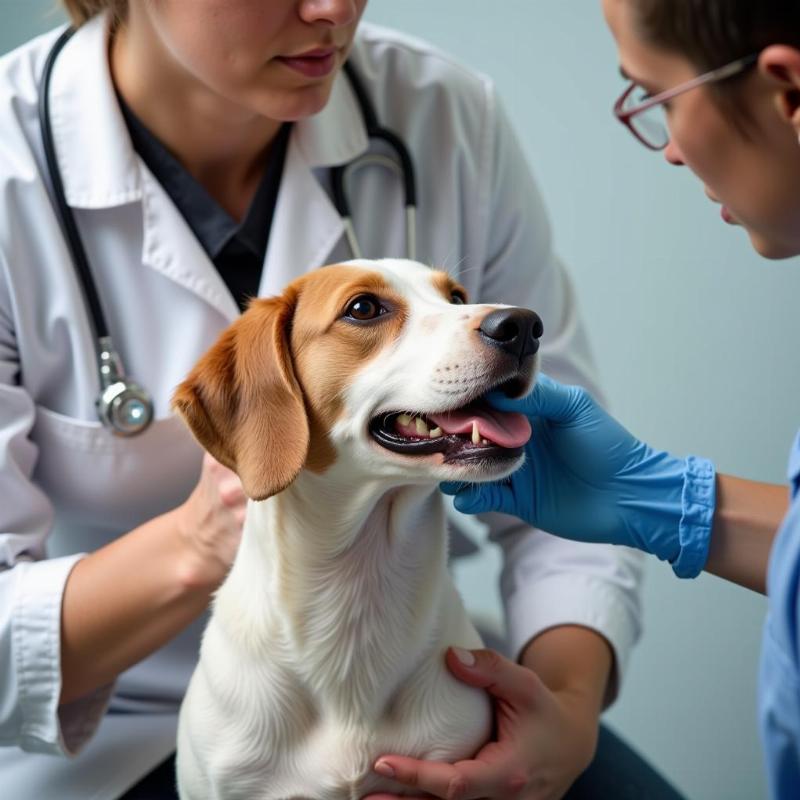Petechiae in dogs are small, pinpoint red or purple spots that appear on the skin or mucous membranes. They indicate bleeding under the skin and can be a sign of various underlying health issues. Understanding what petechiae looks like and what it might signify is crucial for any dog owner. This guide will provide you with the information necessary to identify petechiae, understand its potential causes, and know when to seek veterinary care.
Recognizing Petechiae in Your Canine Companion
Identifying petechiae involves careful observation. Unlike larger bruises or rashes, petechiae are tiny, flat spots that don’t lose color when pressed. They can be challenging to spot, especially on dogs with dark fur. Common locations for petechiae include the gums, belly, inner eyelids, and ears. Regularly checking these areas during grooming can help you detect any changes early on.
Petechiae can sometimes be confused with other skin conditions like flea bites or tick-borne illnesses. However, unlike flea bites, which often appear in clusters and are slightly raised, petechiae are flat. Tick-borne diseases can also cause skin abnormalities, but they often present with other symptoms like fever, lethargy, or joint pain.
Potential Causes of Petechiae in Dogs
Petechiae results from bleeding under the skin. This bleeding can be triggered by various factors, ranging from relatively minor issues to serious medical conditions. Some common causes include:
- Trauma: Injuries, such as a strong blow or bite, can cause blood vessels to rupture, leading to petechiae.
- Infections: Certain bacterial, viral, and parasitic infections can affect blood clotting and cause petechiae. Examples include ehrlichiosis, Rocky Mountain spotted fever, and canine distemper.
- Immune-Mediated Diseases: Conditions like Immune-Mediated Thrombocytopenia (ITP) destroy platelets, essential for blood clotting, increasing the risk of bleeding and petechiae.
- Toxicity: Ingestion of certain toxins, such as rat poison, can interfere with blood coagulation and result in petechiae.
- Certain Medications: Some medications can have side effects that impact platelet function and lead to petechiae.
- Underlying Health Problems: Liver disease, kidney disease, and some types of cancer can also contribute to the development of petechiae.
 Dog Being Examined by a Veterinarian
Dog Being Examined by a Veterinarian
When to Seek Veterinary Care
While not all cases of petechiae indicate a life-threatening condition, it’s crucial to seek veterinary care if you notice these spots on your dog. Early diagnosis and treatment are essential, especially if the underlying cause is a serious illness. Along with visually inspecting your dog, your veterinarian may conduct blood tests, urine analysis, or other diagnostic procedures to determine the cause of the petechiae.
What to Expect at the Vet
Your veterinarian will ask about your dog’s medical history, recent activities, and any potential exposure to toxins. Be prepared to provide detailed information. Based on the examination and test results, your veterinarian will determine the appropriate course of treatment. This might involve medications, supportive care, or further diagnostic tests.
Preventing Petechiae in Dogs
While not all causes of petechiae are preventable, some measures can reduce the risk. Keeping your dog up-to-date on vaccinations can protect against certain infectious diseases. Preventing exposure to toxins, providing a balanced diet, and regular veterinary check-ups can also contribute to overall health and reduce the likelihood of developing petechiae.
Conclusion
Petechiae in dogs can be a concerning sign, indicating a range of underlying health problems. By understanding what petechiae looks like, its potential causes, and the importance of seeking prompt veterinary care, you can help ensure your furry friend receives the necessary attention and treatment. Early detection and intervention can significantly improve outcomes and ensure your dog’s well-being.
FAQ
- What does petechiae look like in dogs? Petechiae appear as small, flat, pinpoint red or purple spots on the skin or mucous membranes.
- Is petechiae always serious? While petechiae can indicate a serious underlying condition, it can also be caused by minor trauma. It’s important to consult a veterinarian for diagnosis.
- Can petechiae go away on its own? Depending on the cause, petechiae may resolve on its own. However, it’s crucial to seek veterinary attention to determine the underlying cause and ensure appropriate treatment.
- How is petechiae diagnosed? Veterinarians diagnose petechiae through physical examination and may conduct further tests, like blood work or urinalysis, to identify the cause.
- How is petechiae treated? Treatment for petechiae depends on the underlying cause and may involve medications, supportive care, or further diagnostic testing.
- Can I prevent petechiae in my dog? While not all causes are preventable, regular vet check-ups, vaccinations, a balanced diet, and preventing exposure to toxins can help reduce the risk.
- What should I do if I notice petechiae on my dog? Contact your veterinarian immediately for an examination and diagnosis.
Beautdogs.us is your trusted resource for comprehensive dog care information, breed expertise, and product recommendations. Whether you’re a new dog owner or a seasoned expert, we offer valuable insights and practical advice to help you navigate the joys and challenges of dog ownership. We’re dedicated to providing you with the tools and knowledge you need to keep your canine companion happy and healthy. For expert guidance and personalized support, contact us at [email protected] or call us at +1 501-555-7529. Visit Beautdogs.us today to learn more.